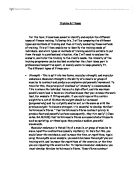Lisa Power HP1 15/4/02
Strength Training Practical
- What is Strength?
Strength is the ability to exert a force against a resistance. There are three types of strength.
- Maximum Strength:
It can be defined as the “greatest force that is possible in a single maximum voluntary contraction.” It involves neither speed nor endurance factors. A slow heavy dead lift is a classic example of this kind of strength. Although the majority of athletic events depend upon speed, maximum strength is necessary where great resistance must be overcome (bodyweight) or controlled (throwing implements) and therefore is essential in varying degrees, in athletic events.
- Elastic Strength:
It can be defined as the “ability to overcome a resistance with a fast contraction.” Both the contractile and elastic components of the muscle are assisted by reflex contraction in the expression of strength at speed. This ability is relevant to almost every event, and the “explosive” quality is especially necessary in jumping, throwing and sprinting.
- Strength Endurance:
This is the “ability to express force many times over in an endurance environment.” It is an important component in events involving lactic anaerobic endurance, and also in activities such as multiple squat thrusts, sit-ups and press-ups.
- Types of Muscular Activity:
- The three different classifications of strength must be given close attention during training and the planning of training. The different types of muscular activity must also be considered.
- Static (Isometric):
Involves muscle tensions, which don’t result in the muscle changing length. The force expressed by the athlete must be equal to, and balance, the force being expressed.
- Dynamic:
This takes place when the force expressed by the athlete doesn’t equal that imposed by the resistance. Dynamic muscular activity is divided into overcoming (concentric) strength and yielding (eccentric) strength.
- Elastic Eccentric:
Work in which the resistance is less than the resistance which the athlete can express.
- Plastic Eccentric:
Work in which the resistance is greater than the athlete’s maximum isometric strength at any point in the range of motion.
- How to Develop each Strength:
- Maximum Strength:
It can be developed with:
-Weight training – Free and machine.
-Low reps – High intensity.
- Elastic Strength:
It can be developed with:
-Conditioning exercises.
-Medicine ball exercises.
-Ploymetric exercises such as bounding for example.
-Weight training – Free and machine.
- Strength Endurance:
It can developed with:
-Circuit training – High reps – Lower intensities.
-Dumbbell exercises.
-Weight training – Free and machine.
-Hill and harness running.
- What is strength training?
“Strength training is defined as “ the use of progressive resistance methods to increase ones ability to exert or resist force.” These methods include body weight, free weights and machines.
Anytime an athlete competes and trains they are at risk to injuries. In strength training, lifting loads that are greater than the athlete can handle or poor techniques are common causes of injury.” ()
- Benefits of Strength Training:
1.Increased Metabolic Rate:
Strength training increases the body’s metabolic rate, causing it to burn more calories throughout the day.
2.Increasing and Restoring Bone Density:
Inactivity and aging can lead to a decrease in bone brittleness. Studies have clearly proven that consistent strength training can increase bone development and therefore prevent Osteoporosis.
3.Increased Lean Muscle Mass and Muscle Strength, Power, and Endurance.
4.Injury Prevention:
A wide variety of sports-related or life-related injuries can be prevented through strengthening muscle and joints.
5.Improved Balance, Flexibility, Mobility and Stability:
Stronger and more resilient muscles increase balance, which means more comfortable living and fewer falls and accidents.
6.Decreased Risk of Coronary Disease:
Participation in a consistent strength-training programme can have a variety of affiliated health benefits including decreasing cholesterol and lowering your blood pressure.
7.Aids Rehabilitation and Recovery:
One of the best ways to heal many types of injuries is to strengthen the muscle surrounding the injured area. The stronger your muscles, the quicker the healing process.
8.Enchanced Performance in Sports or Exercise:
No matter what your favourite sport or physical activity, with the proper strength-training programme, your performance can be unquestionably be improved, strength training does so.







